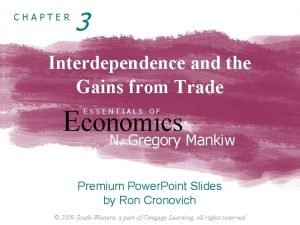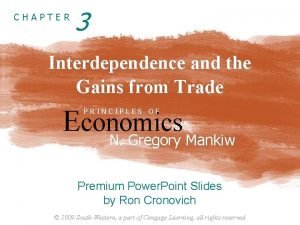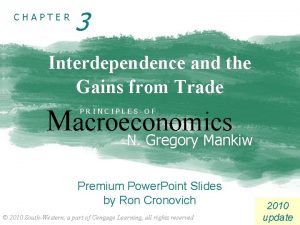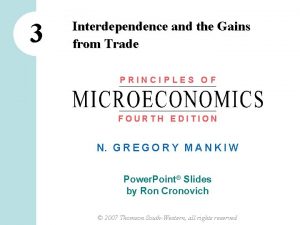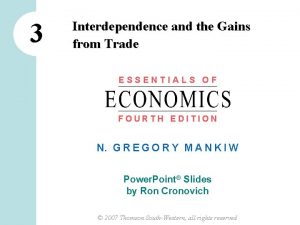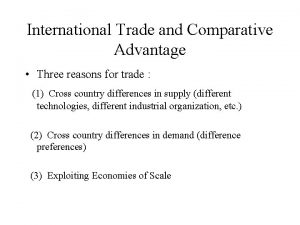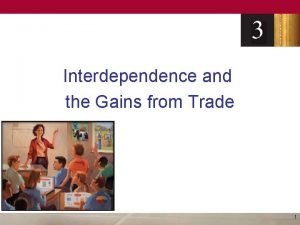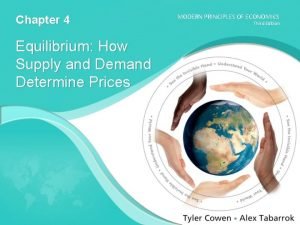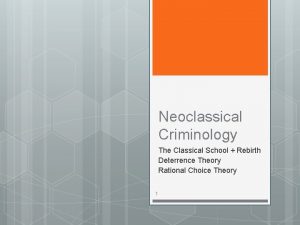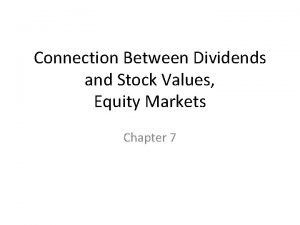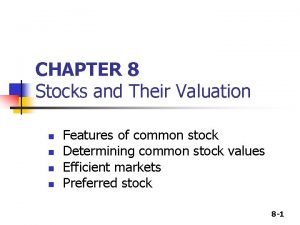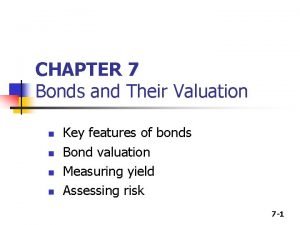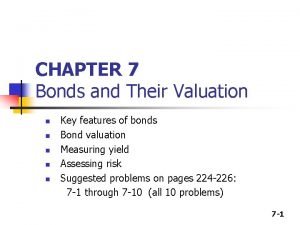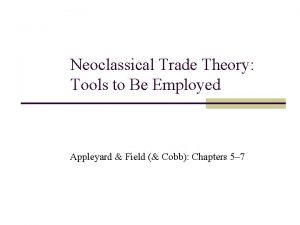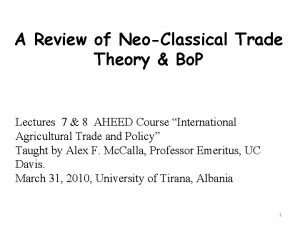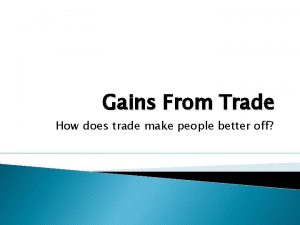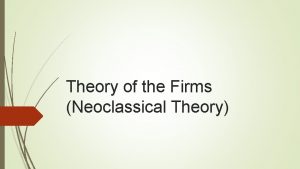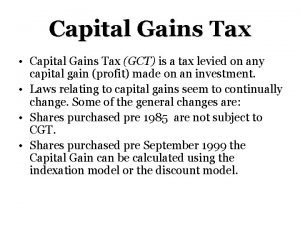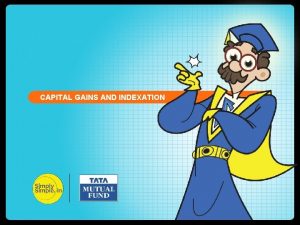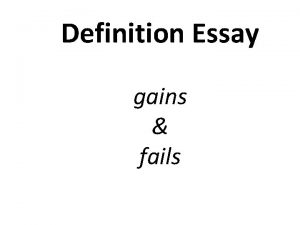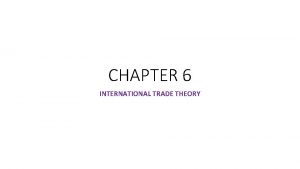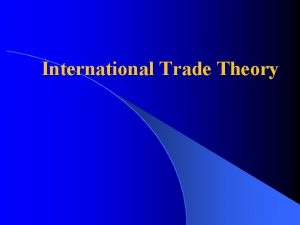Chapter 6 Gains from Trade in Neoclassical Theory






























- Slides: 30

Chapter 6 Gains from Trade in Neoclassical Theory Mc. Graw-Hill/Irwin Copyright © 2010 by The Mc. Graw-Hill Companies, Inc. All rights reserved.

Learning Objectives § Describe economic equilibrium in a country that has no trade. § Discover the welfare enhancing impact of opening a country to trade. § Demonstrate that either supply differences or demand differences between countries are sufficient to generate a basis for trade. § Distinguish the implications of key assumptions in the neoclassical trade model. 6 -2

Problems With Classical Theory § Labor theory of value is unrealistic. § Assumption of constant opportunity costs is too restrictive. § Demand is largely ignored. 6 -3

Autarky Equilibrium § In the absence of trade • producers will seek to maximize profits. • consumers will seek to maximize utility. 6 -4

Production Equilibrium In Autarky § Producers will choose to produce where the relative cost of producing one more unit of X is just equal to the relative price at which the producer can sell a unit of X. § That is, equilibrium occurs where MCX/MCY = PX/PY. 6 -5

Producer Equilibrium in Autarky Y At point E, MCX/MCY = PX/PY. E Autarky Price Line PPF X 6 -6

Consumer Equilibrium in Autarky § Given relative prices (PX/PY) and income, consumers will choose a combination of X and Y that puts them on the highest possible community indifference curve. § Consumer equilibrium occurs where (MUX/MUY) = (PX/PY). 6 -7

Consumer Equilibrium Y Budget constraint E CI 4 CI 3 CI 2 CI 1 X 6 -8

Autarky Equilibrium § In equilibrium, supply and demand jointly determine PX/PY, and therefore how much X and Y is produced (and consumed). 6 -9

Autarky Equilibrium Y E Y 1 Community indifference curve Price line PPF X 1 X 6 -10

The Introduction of International Trade § Trade will cause relative prices to change. § Producers will respond to this by altering relative production of goods X and Y. § Consumers will respond to this by altering relative consumption of goods X and Y. 6 -11

Production in Trade § Let’s suppose that Country A has a comparative advantage in good X. § What will happen to the relative price of good X as Country A moves to trade? § It will rise (otherwise, Country A would not wish to produce more of good X in order to export it). 6 -12

Production in Trade Y Steeper int’l price line means PX/PY has increased. E Y 1 E' Y 2 Autarky Price Line Int’l Price Line X 1 X 2 X 6 -13

Trade Equilibrium Y Y 3 Country A exports X 3 X 2 (the distance FE’), and imports Y 3 Y 2 (the distance FC’). C' imports Y 2 F E' exports X 3 X 2 X 6 -14

Movement From Autarky to Trade § Movement to trade causes relative price of good X to rise. § Higher relative price means more X will be produced, less Y. § Higher relative price of X lowers consumption of X, raises consumption of Y. § Extra X is exported, shortfall in Y is met by imports. 6 -15

Production and Consumption Gains from Trade § There are two distinct sources of trade gains • Consumption gain: even if producers don’t change production levels, welfare is enhanced. • Production gain: specialization in the comparative advantage product leads to higher welfare. 6 -16

Consumption Gains Y Even if producers don’t change production levels in response to a change to (Px/Py)2, the new consumer equilibrium at C is on a higher indifference curve. C' C E E' (Px/Py)2 X 6 -17

Production Gains Y Eventually producers adjust production levels to E’. This permits additional gains to C’. C' C E E' (Px/Py)2 X 6 -18

Countries A and B Together § Let’s continue to suppose that A has a comparative advantage in good X. § Therefore, B must have a comparative advantage in good Y. § It must also be true that (PX/PY)A < (PX/PY)B. 6 -19

Exports, Imports in A and B Y Country A Y 1 e' Y 5 C' Y 3 Country B Y Exp. E Imp. E' Y 2 c' Imp. Exp. X 3 X 1 e Y 4 Y 6 X 2 X X 5 X 4 X 6 -20

Minimum Conditions for Trade § Trade will be mutually advantageous as long as the two countries’ APRs differ. § This can occur because of: • differences on the supply side, or • differences on demand side, or • Both. 6 -21

Identical Demand Conditions § Suppose that the citizens of Country A have the exact same tastes and preferences as the citizens of Country B. § Then their community indifference curves would be identical. § Autarky prices will still differ between the countries as long as the countries differ on their supply sides. 6 -22

Identical Demand Conditions (PX/PY)T Y Y 5 CI 1 f C’, c’ CI 2 Y 3 F (PX/PY)T X 5 X 2 X 3 X 6 -23

Identical Demand Conditions § Even if demand conditions are the same, differences in supply conditions would cause differences in APRs across countries, and so: • Trade could still be mutually advantageous. • Implicitly, this is what is going on in the Classical model. 6 -24

Identical Supply Conditions § What if two countries have identical technologies and resource endowments? § Then their PPFs would be identical. § The Classical model would predict no trade, but what does the Neoclassical model show? 6 -25

Identical Supply Conditions Y PPF for both countries X 6 -26

Identical Supply Conditions Y Y 1 (CI 1)A E (PX/PY)A e Y 4 (PX/PY)B (CI 1)B X 1 X 4 X 6 -27

Identical Supply Conditions Y Y 1 E Y 3 E’, e' e Y 4 X 1 X 3 X 4 (PX/PY)T X 6 -28

Identical Supply Conditions Y Y 2 Y 1 C' E Y 3 E’, e' e Y 4 Y 5 X 2 X 1 X 3 X 4 c' X 5 X 6 -29

Identical Supply Conditions § Even if supply conditions are the same, differences in demand conditions would cause differences in APRs across countries, and so: • Trade could still be mutually advantageous. • This was not a possibility in the Classical model, because it assumed away demand. 6 -30
 Chapter 3 interdependence and the gains from trade
Chapter 3 interdependence and the gains from trade Interdependence and the gains from trade
Interdependence and the gains from trade Chapter 3 interdependence and the gains from trade answers
Chapter 3 interdependence and the gains from trade answers Interdependence and the gains from trade chapter 3
Interdependence and the gains from trade chapter 3 Chapter 3 interdependence and the gains from trade summary
Chapter 3 interdependence and the gains from trade summary Interdependence and the gains from trade
Interdependence and the gains from trade Difference between classical theory and neoclassical theory
Difference between classical theory and neoclassical theory Neoclassical growth theory vs. endogenous growth theory
Neoclassical growth theory vs. endogenous growth theory Gains from trade
Gains from trade Interdependence and the gains from trade
Interdependence and the gains from trade How to calculate unexploited gains from trade
How to calculate unexploited gains from trade Neoclassical theory criminology
Neoclassical theory criminology Neoclassical criminology essay
Neoclassical criminology essay Classical school of criminology
Classical school of criminology Neoclassical theory of crime
Neoclassical theory of crime Trade diversion and trade creation
Trade diversion and trade creation Umich
Umich Which is the most enduring free trade area in the world?
Which is the most enduring free trade area in the world? The trade in the trade-to-gdp ratio
The trade in the trade-to-gdp ratio Fair trade not free trade
Fair trade not free trade Trade diversion and trade creation
Trade diversion and trade creation Tramp chartering
Tramp chartering What was the triangular trade
What was the triangular trade When did wwi begin
When did wwi begin Fsa scale scores learning gains 2021
Fsa scale scores learning gains 2021 Dividend yield and capital gains yield
Dividend yield and capital gains yield Italian gains in ww1
Italian gains in ww1 Current dividend
Current dividend Expected capital gains yield formula
Expected capital gains yield formula Junk bond ratings
Junk bond ratings Current yield formula
Current yield formula
